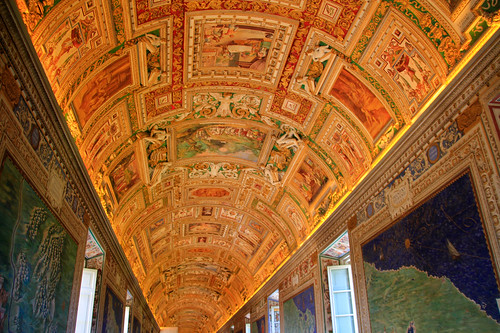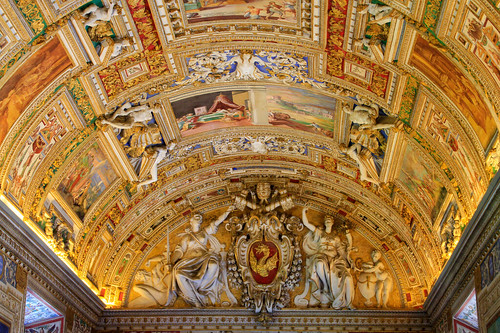The facade was build by Carlo Maderno in 1602. It has been criticized as too squat. In Maderno's defense, there were supposed to be two bell towers, one on each side. One of the towers was even built (by Bernini, no less), but it developed cracks and had to be torn down.

This view shows contributions from several artists. The dome, originally designed by Michelangelo, was redesigned and raised by Giacomo della Porta. You can also see a piece of Maderno's facade. The sculptures are by Bernini. The building on the right is the Sistine Chapel.

One of the Michelangelo's other contributions to the papacy - the design of the uniforms for the Swiss guards.

Each of the posts supporting St Peter's dome is huge - more than 200 feet in circumference. They would overpower the space if not for the Baldacchino in the center - created by Bernini more than a century after the posts were sunk in. To give you an idea of the immensity of this space - the Baldacchino is 8 stories high.

The top of Bernini's Baldacchino is perfectly aligned with the top of the dome.

The dome of St Peter's as it's seen from the inside follows the shape on Michelangelo's blueprints. Michelangelo never got to raise the dome - he only got as far as the drum (the short cylinder that's holding up the dome and has the windows in it). It's not that short though - just for comparison, the letters on the bottom of the drum (which spell out in Latin "Thou art Peter and on this rock I will build my church") are 7 feet tall each.

This statue and tomb of Leo XI is all out of proportion with his contributions to the papacy. Leo XI was another unlucky Medici pope. He is called the Lightning Pope, because his papacy lasted only 26 days. He caught cold when taking possession of the Basilica of St John Lateran (the official church of the pope in his capacity as the Bishop of Rome) and died a few days later.

The dome is basically a vault, but with arches crossing in the middle, instead of being parallel to each other.

Detail of the mosaic on the drum supporting the dome. The whole mosaic is made from more than 5 million pieces.

The basilica is so huge that its roof serves as a plaza for tourists, complete with a visitor center.

The view from the roof is incredible. The entire layout was completed by Bernini - the colonnade, the central avenue, and even the bridge over the Tiber that it leads to. The wall on the left side that leads from St Peter's to the round Hadrian's castle in the distance contains a passageway by which the popes used to escape in the times of trouble.

Close-up of Bernini's sculptures on the top of the facade.

The dome of St Peter's actually consists of two domes. The inner dome follows the original design by Michelangelo. The outer dome was revised by Giacomo della Porta and made taller. This dome was only the second dome raised in Europe after the Pantheon. The first one was for the cathedral in Florence, and it took 14 years. St Peter's dome was raised in astonishing two and a half years, by masons working 24x7. (That's a testimony to the impatience of Renaissance popes.)

Besides the visitor center, the roof of St Peter's also hosts a souvenir shop and a snack place.

And a post office!




























